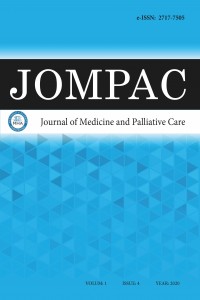Abstract
Leiomyosarcoma is a rare tumor of smooth muscle origin, most commonly seen in retroperitoneum. It is usually seen after the 5th decade equally among women and men. Among the visceral organs, it is most commonly seen in the uterus and constitutes 1% of malignant tumors of the stomach. Here, a case of giant leiomyosarcoma located in the stomach was discussed in the light of the literature. A 74-year-old female patient underwent wedge resection in the general surgery clinic for gastric tumor. Macroscopic examination of the material revealed a soft nodular lesion measuring 14x10x8.5 cm. The lesion was submucosal and extended to the muscularis propria. Histopathological examination of the lesion revealed a cellular proliferation of spindle cells with eosinophilic cytoplasm. Mitosis, pleomorphism and necrosis were observed in these cells. Immünohistochemical study revealed positive staining with SMA, desmin and vimentin, negative staining with DOG-1, CD117. Thus, the patient was diagnosed as leiomyosarcoma. Although gastric leiomyosarcoma is very rare, it should be kept in mind in the differential diagnosis of submucosal tumoral lesions, especially gastrointestinal stromal tumor (GIST). In these tumors, immünohistochemical study is very useful in differentiation from GIST.
References
- Yamamoto H, Handa M, Tobo T, et al. Clinicopathological features of primary leiomyosarcoma of the gastrointestinal tract following recognition of gastrointestinal stromal tumors. Histopathology 2013; 63: 194-207
- Sato T, Akahoshi K, Tomoeda N, et al. Leiomyosarcoma of the stomach treated by endoscopic submucosal dissection. Clin J Gastroenterol 2018; 11: 291-6.
- Insabato L, Di Vizio D, Ciancia G, et al. Malignant gastrointestinal leiomyosarcoma and gastrointestinal stromal tumor with prominent osteoclast-like giant cells. Arch Pathol Lab Med 2004; 128: 440-3.
- Kang WZ, Xue LY, Tian YT, et al. Leiomyosarcoma of the stomach: A case report. World J Clin Cases 2019; 7: 3575-82.
- Farrugia G, Kim CH, Grant CS, et al. Leiomyosarcoma of the stomach: determinants of long-term survival. Mayo Clin Proc 1992; 67: 533-6.
- Garg RM, Alrajjal AM, Berri RM, et al. Primary gastric leiomyosarcoma: a rare entity. Am J Gastroenterol 2017; 112: 1387–8.
- Hasnaoui A, Jouini R, Haddad D, et al. Gastric leiomyosarcoma and diagnostic pitfalls: a case report. BMC Surgery 2018; 18: 62.
- Hilal L, Barada K, Mukherji D, et al. Gastrointestinal (GI) leiomyosarcoma (LMS) case series and review on diagnosis, management, and prognosis. Med Oncol 2016; 33: 20.
- Miettinen M, Monihan JM, Sarlomo-Rikala M, et al. Gastrointestinal stromal tumors/smooth muscle tumors (GISTs) primary in the omentum and mesentery: clinicopathologic and immünohistochemical study of 26 cases. Am J Surg Pathol 1999; 23: 1109-18.
- Miettinen M, Sarlomo-Rikala M, Lasota J. Gastrointestinal stromal tumors: recent advances in understanding of their biology. Hum Pathol 1999; 30: 1213-20.
Abstract
Leiomyosarkom en sık retroperitonda görülen düz kas orijinli nadir bir tümördür. Genelde 5. dekattan sonra kadın ve erkeklerde eşit oranda görülür. Visseral organlar arasında en sık uterusta izlenmekte olup, mide malign tümörlerinin %1’ini oluşturur. Burada mide yerleşimli dev bir leiomyosarkom olgusu literatür eşliğinde tartışıldı. 74 yaşında kadın hasta, gastrik tümöral lezyon nedeniyle genel cerrahi kliniğinde wedge rezeksiyon uygulandı. Materyalinin makroskopik incelemesinde 14x10x8,5 cm ölçülerinde yumuşak kıvamlı nodüler bir lezyon saptandı. Lezyon submukozal yerleşimli olup muskularis propriaya da uzanım göstermekte idi. Lezyonun histopatolojik incelemesinde eozinofilik sitoplazmaya sahip iğsi hücrelerin sellüler bir proliferasyonu görüldü. Bu hücrelerde mitoz, pleomorfizm ve nekroz izlendi. Yapılan immünhistokimyasal çalışmada SMA, desmin ve vimentin ile pozitif boyanma DOG-1 ve CD117 ile de negatif boyanma saptandı. Bu bulgular eşliğinde olguya leiomyosarkom tanısı verildi. Mide yerleşimli leiomyosarkomlar oldukça nadir görülmekle beraber submukozal tümöral lezyonların, özellikle de gastrointestinal stromal tümör (GİST)’ün , ayırıcı tanısında mutlaka akılda tutulmalıdır. Bu tümörlerin GİST’ten ayırımında immünhistokimyasal çalışma oldukça yararlıdır.
Keywords
References
- Yamamoto H, Handa M, Tobo T, et al. Clinicopathological features of primary leiomyosarcoma of the gastrointestinal tract following recognition of gastrointestinal stromal tumors. Histopathology 2013; 63: 194-207
- Sato T, Akahoshi K, Tomoeda N, et al. Leiomyosarcoma of the stomach treated by endoscopic submucosal dissection. Clin J Gastroenterol 2018; 11: 291-6.
- Insabato L, Di Vizio D, Ciancia G, et al. Malignant gastrointestinal leiomyosarcoma and gastrointestinal stromal tumor with prominent osteoclast-like giant cells. Arch Pathol Lab Med 2004; 128: 440-3.
- Kang WZ, Xue LY, Tian YT, et al. Leiomyosarcoma of the stomach: A case report. World J Clin Cases 2019; 7: 3575-82.
- Farrugia G, Kim CH, Grant CS, et al. Leiomyosarcoma of the stomach: determinants of long-term survival. Mayo Clin Proc 1992; 67: 533-6.
- Garg RM, Alrajjal AM, Berri RM, et al. Primary gastric leiomyosarcoma: a rare entity. Am J Gastroenterol 2017; 112: 1387–8.
- Hasnaoui A, Jouini R, Haddad D, et al. Gastric leiomyosarcoma and diagnostic pitfalls: a case report. BMC Surgery 2018; 18: 62.
- Hilal L, Barada K, Mukherji D, et al. Gastrointestinal (GI) leiomyosarcoma (LMS) case series and review on diagnosis, management, and prognosis. Med Oncol 2016; 33: 20.
- Miettinen M, Monihan JM, Sarlomo-Rikala M, et al. Gastrointestinal stromal tumors/smooth muscle tumors (GISTs) primary in the omentum and mesentery: clinicopathologic and immünohistochemical study of 26 cases. Am J Surg Pathol 1999; 23: 1109-18.
- Miettinen M, Sarlomo-Rikala M, Lasota J. Gastrointestinal stromal tumors: recent advances in understanding of their biology. Hum Pathol 1999; 30: 1213-20.
Details
| Primary Language | Turkish |
|---|---|
| Subjects | Health Care Administration |
| Journal Section | Case Report [en] Olgu Sunumu [tr] |
| Authors | |
| Publication Date | December 18, 2020 |
| Published in Issue | Year 2020 Volume: 1 Issue: 4 |
TR DİZİN ULAKBİM and International Indexes (1d)
Interuniversity Board (UAK) Equivalency: Article published in Ulakbim TR Index journal [10 POINTS], and Article published in other (excuding 1a, b, c) international indexed journal (1d) [5 POINTS]
|
| ||
|
|
|
Our journal is in TR-Dizin, DRJI (Directory of Research Journals Indexing, General Impact Factor, Google Scholar, Researchgate, CrossRef (DOI), ROAD, ASOS Index, Turk Medline Index, Eurasian Scientific Journal Index (ESJI), and Turkiye Citation Index.
EBSCO, DOAJ, OAJI and ProQuest Index are in process of evaluation.
Journal articles are evaluated as "Double-Blind Peer Review".













